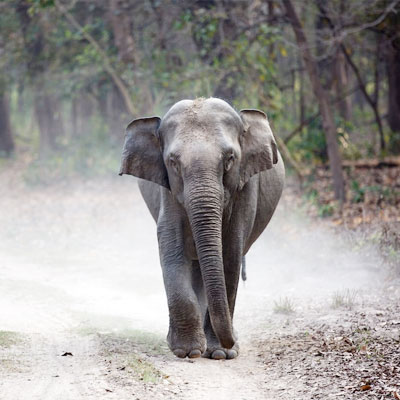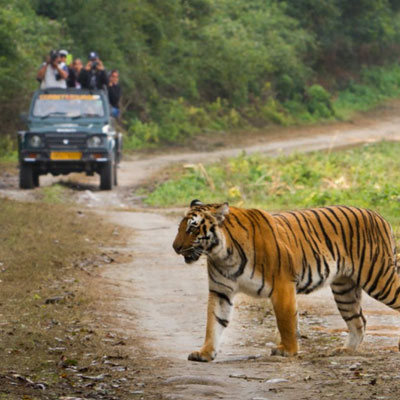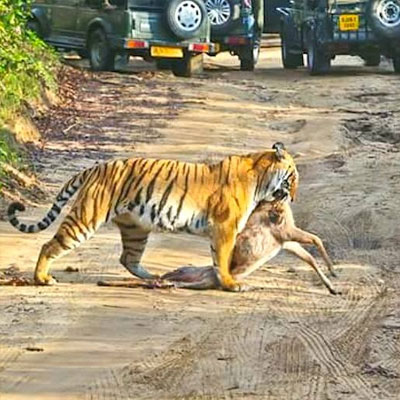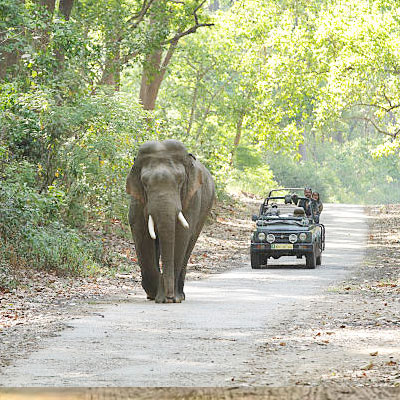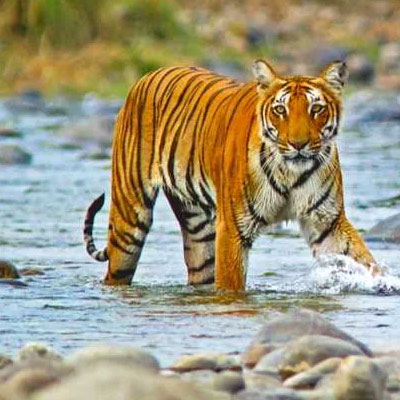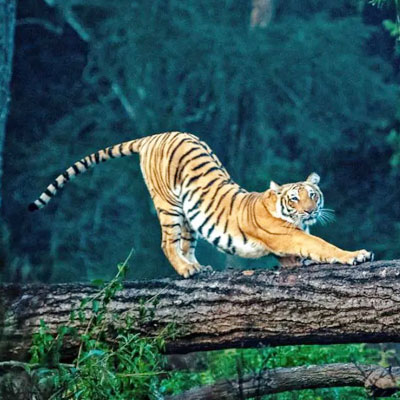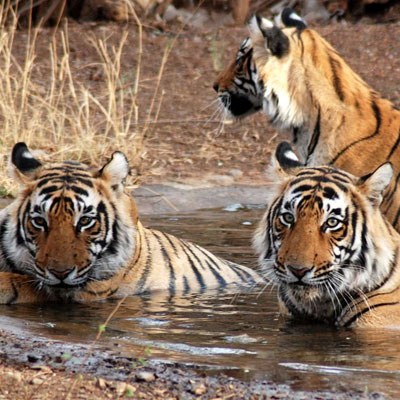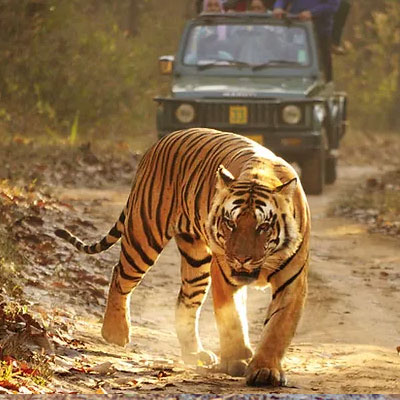
Jim Corbett Corporate Group Tour Package:-
Organizing a corporate group tour to Jim Corbett National Park can be an excellent choice for team building and enjoying the natural beauty and wildlife of the region. Here are details for a corporate group tour package to Jim Corbett, including accommodation and safari options:
Corporate Group Tour Package to Jim Corbett:
Duration: The duration of the tour package can vary based on your preferences, but a typical corporate group tour to Jim Corbett may last for 2 to 4 days.
Accommodation:
- Choose from a range of accommodations, including luxury resorts, eco-friendly lodges, and forest rest houses.
- Many resorts in and around Jim Corbett offer facilities for corporate meetings, conferences, and team-building activities.
- Ensure that your chosen accommodation can accommodate your entire group comfortably.
Safari Options:
- Jim Corbett National Park offers several safari zones, each with its unique charm. Depending on your group’s interests, you can choose one or more safari zones. Some of the popular zones include Bijrani, Jhirna, Dhikala, and Durgadevi.
- Safari options include jeep safaris, canter safaris, and elephant safaris. Jeep safaris are the most common choice for bird watching and wildlife spotting.
Corporate Activities:
- Organize team-building activities and games within the resort premises or in the natural surroundings of the park.
- Plan a group bonfire, nature walk, or outdoor activities to engage team members.
- Consider arranging a conference or meeting space with audio-visual equipment for corporate discussions.
Sightseeing:
- Apart from wildlife safaris, explore nearby attractions such as the Corbett Museum and Garjiya Devi Temple.
- Visit the Kosi River for a relaxing time by the riverside.
Cuisine:
- Most resorts offer a variety of dining options, including buffet spreads and a la carte menus. Explore the local cuisine and enjoy traditional Kumaoni dishes.
- Organize group meals and dine together for a bonding experience.
Logistics and Transport:
- Arrange for transportation from your corporate location to Jim Corbett. It can be by train, bus, or private vehicles.
- Hire local transportation for moving within the park and for safari excursions.
Safety and Guidelines:
- Ensure that your group adheres to all safety regulations and park guidelines during safaris and outdoor activities.
- Respect the natural environment and wildlife. Avoid making loud noises that may disturb animals.
Advance Booking:
- Jim Corbett National Park is a popular destination, especially during peak tourist seasons. It’s essential to book your accommodation and safari permits well in advance.
Customize your corporate group tour package based on the number of participants, budget, and preferences. Collaborate with a reliable tour operator or resort to create an itinerary that caters to your group’s specific needs and objectives.
How to Reach Jim Corbett :-
Jim Corbett National Park is accessible from various sides or gates, and the choice of gate depends on your starting point and the specific area of the park you wish to explore. Here’s how to reach Jim Corbett from different sides:
1. Ramnagar Side (Dhikala and Bijrani Zones):
- By Train: The nearest railway station is Ramnagar Railway Station (RMR), which is well-connected to major cities like Delhi and Lucknow. From Ramnagar, you can hire a taxi or take a shared jeep to reach the park’s entry gates.
- By Road: Ramnagar is well-connected by road to nearby cities like Delhi, Nainital, and Haridwar. You can drive to Ramnagar or take a bus from these cities. Once in Ramnagar, hire a taxi or take a shared jeep to the park’s gates.
2. Jhirna Side:
- By Road: Jhirna is accessible from Ramnagar, and you can follow the same route as mentioned for the Ramnagar side. It’s relatively close to Ramnagar, and you can hire a taxi to reach Jhirna Zone.
3. Durgadevi Side:
- By Road: Durgadevi is also accessible from Ramnagar, and you can reach it by following the road to the Ramnagar-Dhikala route. It’s a bit farther from Ramnagar than the other zones.
4. Kalagarh Side (Sonanadi Zone):
- By Road: Kalagarh is located on the western side of the park and can be reached from Kotdwar, which is the nearest major town. You can take a train to Kotdwar from Delhi and then hire a taxi to reach Kalagarh.
5. Vatanvasa Side (Dhikala Zone):
- By Road: Vatanvasa is located on the northern side of the park, and you can reach it from Kashipur or Corbettganj railway stations. Kashipur is well-connected to Delhi, and from there, you can hire a taxi or take a bus to reach Vatanvasa.
6. Kotabagh Side (Dhikala Zone):
- By Road: Kotabagh is located to the northwest of the park and can be reached by road from various cities in Uttarakhand. The nearest railway station is Moradabad, from where you can hire a taxi to Kotabagh.
7. Kotdwar Side (Dhikala Zone):
- By Train: Kotdwar is the nearest railway station to the Sonanadi Zone and can be reached by train from Delhi. From Kotdwar, you can hire a taxi to reach the park’s gates.
It’s important to note that while reaching the park’s entry gates is relatively straightforward, you’ll need to arrange for permits and safari bookings in advance, depending on the zone you plan to visit. Additionally, road conditions may vary, so it’s advisable to check the latest information and plan your transportation accordingly.
Do and do not in jim corbett at safari time:-
When visiting Jim Corbett National Park during a safari, it’s crucial to adhere to guidelines and follow ethical practices to ensure the safety of both wildlife and visitors. Here are some “dos” and “do nots” to keep in mind during your safari in Jim Corbett:
Dos:
Follow the Park Rules:
- Always abide by the rules and regulations set by the forest department and your safari guide. These rules are in place to protect the park’s wildlife and ensure visitors’ safety.
Respect Wildlife:
- Maintain a respectful distance from animals and avoid any behavior that may provoke or disturb them. Do not attempt to feed or touch any wildlife.
- Keep noise levels low to avoid scaring animals away.
Stay Inside the Vehicle:
- During a jeep or canter safari, remain inside the designated vehicle at all times. Do not exit the vehicle unless instructed by your guide.
Listen to Your Guide:
- Pay close attention to your safari guide’s instructions. They are knowledgeable about the park’s wildlife and safety protocols.
Use Binoculars and Cameras:
- Binoculars and cameras are essential tools for wildlife enthusiasts. Use them to observe animals from a safe distance without disturbing them.
Pack Essentials:
- Bring essentials like water, sunscreen, insect repellent, a hat, and comfortable clothing. Weather conditions in the park can vary.
Dispose of Trash Properly:
- Carry a small bag for your trash and dispose of it in designated bins outside the park. Litter can harm wildlife and pollute the environment.
Be Patient:
- Wildlife sightings can be unpredictable. Be patient and quiet while waiting for animals to appear.
Do Nots:
Do Not Litter:
- Absolutely do not litter within the park. Carry all trash back with you and dispose of it responsibly.
Do Not Make Loud Noises:
- Keep noise levels to a minimum to avoid scaring away animals and disrupting their natural behavior.
Do Not Feed Wildlife:
- Feeding wildlife is harmful to their health and disrupts their natural diet. Never attempt to feed animals in the park.
Do Not Use Flash Photography:
- Flash photography can startle animals and may be harmful to their eyes. Avoid using flash while photographing wildlife.
Do Not Stray from the Vehicle:
- Never step out of the vehicle during a safari unless your guide allows it. It can be dangerous and disruptive to the animals.
Do Not Harass or Chase Wildlife:
- Do not chase animals or try to get too close to them. This can be stressful for wildlife and potentially dangerous.
Do Not Smoke:
- Smoking is generally prohibited during safaris due to the fire risk it poses to the forest.
Do Not Overspeed:
- Follow the speed limits set by the park authorities to ensure the safety of both visitors and wildlife.
By following these dos and do nots, you can have a safe and respectful safari experience in Jim Corbett National Park while contributing to the conservation of its precious biodiversity.

